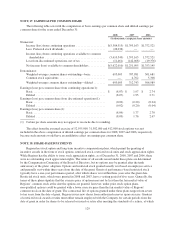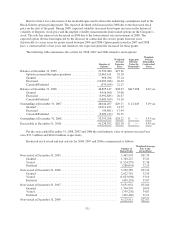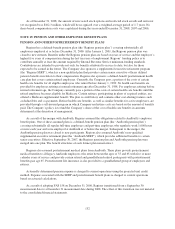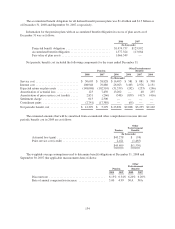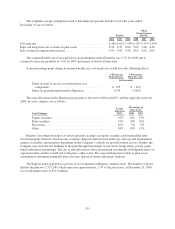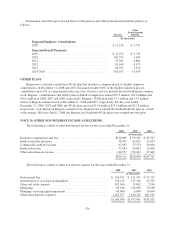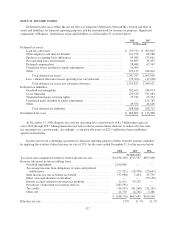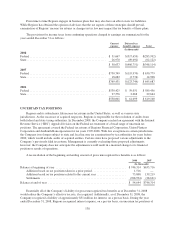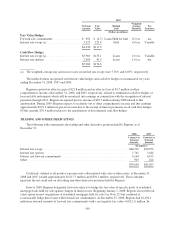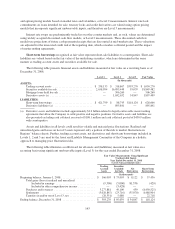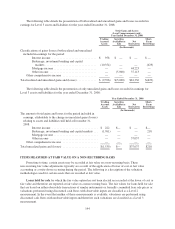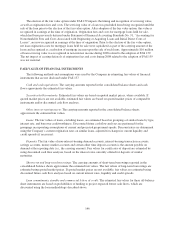Regions Bank 2008 Annual Report Download - page 149
Download and view the complete annual report
Please find page 149 of the 2008 Regions Bank annual report below. You can navigate through the pages in the report by either clicking on the pages listed below, or by using the keyword search tool below to find specific information within the annual report.
approximately $39 million. During 2009, the Company anticipates filing amended state and local income tax
returns to reflect the agreement reached with the IRS for tax years 1999-2006. If completed and accepted by the
states, the gross unrecognized tax benefits could decrease by approximately $55 million.
NOTE 22. DERIVATIVE FINANCIAL INSTRUMENTS AND HEDGING ACTIVITIES
Regions maintains positions in derivative financial instruments to manage interest rate risk, to facilitate
asset/liability management strategies and to serve the risk management needs of customers. These derivative
instruments include forward rate contracts, Eurodollar futures, interest rate swaps, put and call option contracts,
interest rate floors, and foreign currency contracts. For those derivative contracts that qualify for hedge
accounting, according to FAS 133, Regions designates hedging instruments as either a fair value or cash flow
hedge. Derivative contracts that do not qualify for hedge accounting are classified as trading. The accounting
policies associated with derivative financial instruments are discussed further in Note 1 to the consolidated
financial statements.
Forward rate contracts are commitments to buy or sell financial instruments at a future date at a specified
price or yield. Regions primarily enters into forward rate contracts on market instruments, which expose Regions
to market risk associated with changes in the value of the underlying financial instrument, as well as the credit
risk that the counterparty will fail to perform. Eurodollar futures are futures contracts on three-month Eurodollar
deposits. Eurodollar futures subject Regions to market risk associated with changes in interest rates. Because
futures contracts are cash settled daily, there is minimal credit risk associated with Eurodollar futures. Interest
rate swaps are agreements to exchange interest payments based upon notional amounts. Interest rate swaps
subject Regions to market risk associated with changes in interest rates, as well as the credit risk that the
counterparty will fail to perform. Option contracts involve rights to buy or sell financial instruments on a
specified date or over a period at a specified price. These rights do not have to be exercised. Some option
contracts such as interest rate floors, involve the exchange of cash based on changes in specified indices. Interest
rate floors are contracts to hedge interest rate declines based on a notional amount. Interest rate floors subject
Regions to market risk associated with changes in interest rates, as well as the credit risk that the counterparty
will fail to perform. Foreign currency contracts involve the exchange of one currency for another on a specified
date and at a specified rate. These contracts are executed on behalf of the Company’s customers and are used to
manage fluctuations in foreign exchange rates. The Company is subject to the credit risk that another party will
fail to perform.
HEDGING DERIVATIVES
The following tables summarize the hedging derivative positions utilized by Regions to manage interest rate
risk and facilitate asset/liability strategies as of December 31:
2008
Notional
Amount
Fair
Value
Hedged
Item
Weighted-
Average
Maturity
Pay
Structure
(Dollars in millions)
Fair Value Hedges
Interest rate swaps (a) ................................ $ 5,775 $292.0 Debt 2.6 yrs. Variable
Cash Flow Hedges
Interest rate swaps (a) ................................ $ 7,350 $313.0 Loans 1.9 yrs. Variable
Interest rate options .................................. 3,500 115.9 Loans 1.5 yrs. n/a
Eurodollar futures ................................... 10,000 — Loans 0.3 yrs. n/a
$20,850 $428.9
(a) The weighted-average pay and receive rates on interest rate swaps were 2.45% and 4.58%, respectively.
139


